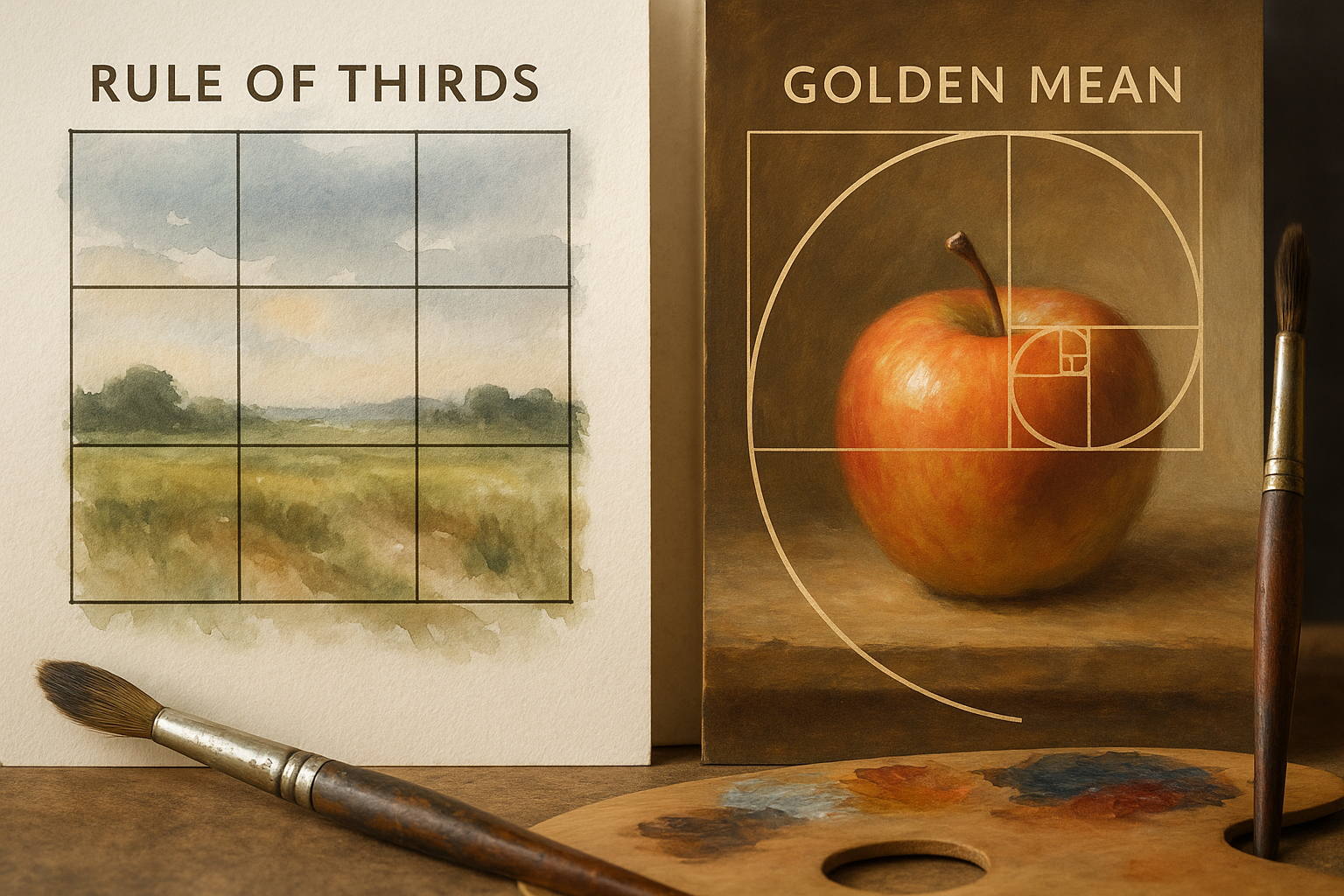Composition is the silent conductor of your painting — it directs the viewer’s eye, sets the emotional tone, and gives your subject its stage. Whether you’re working in the fluid, unpredictable world of watercolor or the rich, layered textures of oil painting, good composition can elevate your work from a pleasant image to a piece that truly sings.
In this post, we’ll look at a few foundational composition principles that work beautifully across both mediums.
📏 1. The Rule of Thirds
One of the simplest and most effective compositional tools is the rule of thirds. Imagine dividing your canvas into a 3×3 grid — two horizontal and two vertical lines. Where these lines intersect are natural focal points.
Placing your subject or key elements along these lines (or at their intersections) creates dynamic, natural balance, as opposed to centering everything, which can feel static.
- In watercolor, where spontaneity reigns, pre-planning this grid lightly in pencil can help keep your wash compositions structured without feeling rigid.
- In oil painting, the rule of thirds helps you anchor your focal point amid layers of detail, especially in landscapes and portraits.
Tip: Try positioning your horizon line on the top third or bottom third, rather than dead center. You’ll be amazed how much more compelling your composition becomes.
🎯 2. Establishing a Focal Point
Every painting needs a clear focal point — the “where should I look first?” moment for your viewer. This could be:
- A brightly lit barn in a foggy field
- A figure bathed in sunlight
- A punch of color amid neutrals
In watercolor, focal points can be emphasized through contrast, value, and reserved whites, while in oil painting, you can use texture, saturation, and thicker impasto to pull the eye.
Ask yourself:
👉 “If someone looked at this painting for just three seconds, what would they notice first?”
If the answer isn’t clear, your composition may need refining.
⚖️ 3. Balance and Visual Weight
Balance isn’t about perfect symmetry — it’s about making sure the visual weight of the painting feels stable. You can balance a large, subtle shape with a smaller but more intense shape, or a dark value against a larger light area.
- Watercolor: The eye is drawn to areas of strong contrast or saturated pigment. Balance bold areas with quiet spaces — let the white of the paper breathe.
- Oil: Balance heavy impasto or dark passages with open, atmospheric zones. Varying your brushwork can also create compositional rhythm.
Think of it like a seesaw: the left side doesn’t have to mirror the right, but it shouldn’t feel like it’s going to topple over either.
➿ 4. Leading Lines and Pathways
Lines — literal or implied — can guide the viewer’s eye through the composition. Roads, rivers, fence lines, architectural elements, or even directional brushstrokes can act as visual pathways.
- A winding path in a landscape can lead the eye from the foreground to the horizon.
- A diagonal shadow can push the gaze toward your focal point.
- Curved lines often create a more lyrical, natural flow, while straight lines lend structure and formality.
This technique is especially powerful in oil landscapes and watercolor urban scenes, where you want to direct attention without over-explaining.
🌬 5. Negative Space and Breathing Room
What you leave out can be just as important as what you include. Negative space gives your subject room to “breathe” and helps avoid visual clutter.
- In watercolor, letting the paper remain untouched can define edges and suggest light without overworking.
- In oil, keeping background areas soft or loosely rendered can push the focal point forward.
Think of negative space as the silence between musical notes — it’s what gives shape and rhythm to the whole.
✍️ 6. Thumbnail Sketches: The Secret Weapon
Before diving into a full painting, take a few minutes to create small, quick thumbnail sketches (in graphite, pen, or even a thin wash). These allow you to experiment with different compositions — moving the horizon line, shifting focal points, playing with balance — without committing hours of work.
This step is invaluable for both watercolorists and oil painters. It keeps your creative energy focused and prevents “composition regret” halfway through a piece.
🎨 Final Thoughts
Good composition isn’t a set of rigid rules — it’s a language. Once you understand the vocabulary (rule of thirds, focal points, balance, negative space), you can bend or break the rules intentionally, not accidentally.
Next time you set up your easel, whether you’re reaching for a soft squirrel mop brush or a palette knife, pause for a moment. Sketch. Shift. Consider. Your future painting will thank you.
✅ Key Takeaways:
- Use the rule of thirds to create natural structure.
- Establish a clear focal point to anchor the viewer’s gaze.
- Balance visual weight, lead the eye with lines, and don’t underestimate negative space.
- Plan ahead with thumbnails — they’re small but mighty.



